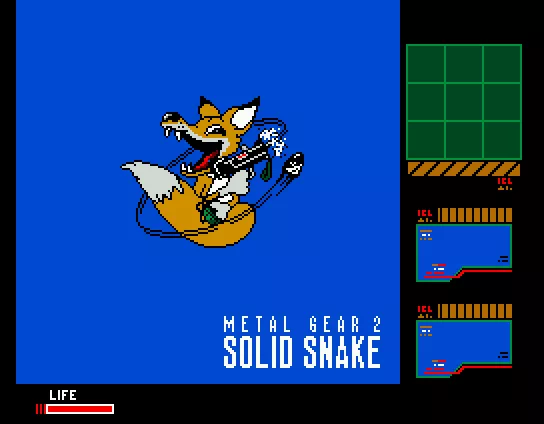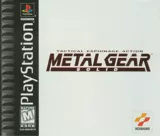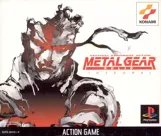Metal Gear 2: Solid Snake
Description
In 1999, a great scientist named Kio Marv invented "oilix", a special petroleum-purifying substance that was supposed to help in the upcoming oil crisis. Shortly after the invention became known in the world, Dr. Marv was abducted. An investigation showed that he was held captive in Zanzibar Land, an isolated state in Central Asia which was ruled by a group of mercenaries from all around the world. Having oilix in addition to nuclear weapons are bound to Zanzibar an invincible state that would sooner or later attempt to conquer the entire world. Roy Campbell, ex-commander of special unit FOXHOUND, sends Solid Snake, the man who has single-handedly brought down the military nation of Outer Heaven four years ago, on a mission to infiltrate Zanzibar and to bring back the scientist and his invention.
Like its predecessor, Metal Gear 2: Solid Snake is a stealth game. The driving element of the gameplay is to stay unnoticed. If guards spot you, you don't have much chance in combat, unless you are armed with appropriate weapons, which aren't easily acquired. Snake can use a variety of weapons and gadgets to help him survive during his mission. He can also hide behind objects, punch guards, and crawl. From time to time he'll have to participate in boss battles, where stealth won't help any more.
Groups +
Screenshots
Credits (MSX version)
24 People (19 developers, 5 thanks) · View all
| Game Programming | |
| Demo Programming | |
| Character Design | |
| Character Support | |
| Scenario | |
| Mechanical Design | |
| Music Compose | |
| Sound Effect | |
| Logo Design | |
| Modeling | |
| Illustration | |
| Special Thanks |
|
| [ full credits ] | |
Reviews
Critics
Average score: 85% (based on 1 ratings)
Players
Average score: 3.9 out of 5 (based on 54 ratings with 3 reviews)
Addictive game with for the time some cool features
The Good
The game has a nice adventure feeling to it with a touch of story telling.
Mapping is less a thing as it was with Metal Gear 1, which is better in my opinion.
The Bad
Backtracking keys and weapons, walking up and down to find that essential piece of equipment to continue can get tedious. Also: I really don't understand how anybody would have finished the game in the 90s without the internet. There's some things, like in Metal Gear 1 that I think you can never figure out by yourself.
The Bottom Line
It's a 2D top down game focused on stealth, and not so much action shooting. It's got a nice flavor of adventure gaming which feels like the 80s point and click adventure games. Nice (although thin) story, and some cool features and humor. It introduces some features which were pretty cool at the time (noise weighs in, stealth etc.)
MSX · by Leon Tiggelman (23) · 2020
The Good
Though Snake’s Revenge is technically the first sequel to Metal Gear, it was done specifically with a western audience in mind and without the input of series’ creator, Hideo Kojima. Due to this, it was quickly ejected from the series’ canon when Kojima got around to making Metal Gear 2: Solid Snake for the MSX2, which wound up being released the same year. I actually kind of liked Snake’s Revenge when I recently played through it, but it felt very safe, never straying too far from the mechanics set in place from its predecessor. Metal Gear 2, on the other hand, finally takes the series forward and cleans up some of the problems that plagued the first game.
Once again, the game follows the exploits of the titular special-ops soldier, Solid Snake, as he attempts to infiltrate a military compound to save a civilian scientist. This time around, there’s a lot more backstory given. The newly founded country of Zanzibarland (not related to the real world Zanzibar, I assume) is waging war on its neighbours, supplied by the only nuclear weapons left on earth, and has captured the aforementioned scientist, who holds a solution to the world’s oil crisis.
While the story itself is pretty interchangeable with that of the first game, Metal Gear 2 goes to greater lengths to actually tell a deeper tale. Many of the bosses and the supporting characters are given a great deal of personal traits and backstory, and will spew them into your face whenever given the chance. A few of the bosses use their death monologues to wax philosophic in a way that’s deeply cheesy, but still rather ambitious for a game made it 1990. Supporting characters in the first Metal Gear were mostly just stationary and confined to individual rooms, and the addition of short cutscenes does a lot to make the plot feel more dynamic without getting too in the way.
Snake’s Revenge suffered for dropping the first game’s interconnected world in favour of a more linear experience, and thankful Metal Gear 2 didn’t follow its example. The Zanzibarland base is completely open for exploration, and once again requires you to scour its every cranny for useful items that allow you to proceed to previously unreachable locations. The base this time around is much more varied, with two distinct buildings as well as the area between. The rooms and hallways are more detailed in a way that’s both functional in terms of gameplay and visually interesting. It doesn’t stray too far from the series’ signature muted, grey-heavy colour scheme, but it does make for an extremely appealing environment to sneak around in.
Despite sharing the same structure, there’s a lot added to Metal Gear 2 that makes it feel almost like an entirely new game. A special radar system was added that allows you to get a view of the sectors around you and greatly expands the active radius of enemies, so rather than their movements being confined to the screen you presently inhabit, they roam a 3 by 3 grid. This greatly cuts down the frequency of moments where you step into a new screen and find yourself directly in a guard’s line of sight. It also means that tripping an alarm can no longer be nulled simply by exiting the screen or killing all the guards who attack. You’re actually required to slip out of sight and hide before the alarm will go back into a neutral state.
Snake can also crawl now, which may seem like a minor addition, but it has a great impact on how the game plays out. Not only can you enter vents for new points of ingress, but you can also hide in small openings that are scattered throughout the game world; a requirement if you trip an alarm. This also ties into the guards’ fancy new sense of hearing, since certain floors will give off sounds that bring the guards to your position. Crawling across grating or singing sand ensures that you don’t tip off an enemy to your location. Of course, it’s sometimes useful to bring a guard around a corner where they can be easily dispatched. In cases like that, you can also knock on walls to get their attention.
This may be a small positive to some, but I was overjoyed to find that the keycard swapping from the first game and Snake’s Revenge has been greatly reduced. Previously, to open locked doors, it was often necessary to root through your pockets to find the correct key card. Now, after picking up a sequence of three cards, you can grab a special key that combines the three keys into one. This cuts down the potential number of key cards you need to attempt from a maximum of nine to just three. When I picked up that first master key, it was like all my Christmases came at once.
The Bad
While perhaps unavoidable in a game like this, Metal Gear 2 features heavy backtracking that gets more pointless and less tolerable as the game goes on. Items are spread between the two buildings that make up the compound and many of them require you to obtain keys from the one building to open doors in the other. This is eased near the start by allowing you to take a shortcut through the sewers of the two buildings, but this is taken away far too early and blocked off in one of the buildings for no real reason. You can cut down the amount of travelling required if you plan carefully and only search for new items in the building you’re currently completing objectives in, but that only gets so far. The annoyance reaches its zenith near the very end, where you’re forced to walk all the way back to a room near the beginning to obtain a key that unlocks one of the very last doors in the game. It is a baffling design decision.
Bosses are improved greatly. Some of the best ones act as puzzles, requiring you to figure out how to defeat them, and these particular battles are especially satisfying. However, the bosses lose their teeth in the later portion of the game, becoming incredibly simple and easy to outwit. There were multiple boss battles that were set up in some elaborate fashion in which I found myself defeating my aggressor in a simple fashion. One fellow couldn’t figure out how to circumvent a set of boxes and found himself victim to a few dozen grenades that I lobbed from a safe spot, but the battlefield we were on suggested that a more intense game of cat and mouse was intended. That wasn’t an isolated incident, and the three bosses that followed after each suffered equally embarrassing defeats. After the creatively designed fights that were set up in the beginning, my expectations were set a little higher than that.
The Bottom Line
It feels like Metal Gear 2: Solid Snake delivers on the promises made in the first game. Everything that made the original great has been expanded on and polished to a bright gloss. Some of the flaws that plagued the first game are still there in some form or another, but compromises were made so that these missteps no longer stand out and frustrate. I thoroughly enjoyed Metal Gear 2 from start to finish, and it feels like the perfect game based on the formula. It’s creative, memorable, and completely OUTSTANDING in almost every way. I recommend it to anyone who’s interested in the early days of the action-stealth genre.
I’d like to disclose that the version of Metal Gear 2 that I played was the port included in the second Metal Gear Solid 3: Subsistence disk on original difficulty. While this is mostly a straight port of the MSX2 version translated to English, it does include some small changes that I have taken into consideration.
MSX · by Adzuken (836) · 2015
The Good
When Hideo Kojima bumped into the Developers of Snakes Revenge on a train, he was influenced to create a real sequel to the MSX game Metal Gear, and here it is!
The sequel Greatly improved on the original metal gear, with better graphics, tougher and more detailed areas to explore, as well as the ability to crawl and knock on walls. the guards also gained a wider field of vision than in the first game witch greatly increased the difficulty. Snake also gained a radar system and a array of new weapons and equipment to aid him in his mission. the game was much harder than its predecessor, but that's not necessarily a bad thing.
The Bad
Nothing immediately comes to mind when trying to think of bad things about this masterpiece? I suppose the bosses where named Ridiculously funny names?
The Bottom Line
This is a GREAT game and i highly recommend you picking up a copy of MGS3 Subsistence just so you can play this masterpiece in its translated glory. i recommend it to any Metal Gear Fan or collector alike, or just a gamer who feels like having a blast from the past.
MSX · by Chris Jeremic (152) · 2009
Trivia
Western release
This game, together with the MSX version of Metal Gear is featured on the extra disc of the Limited Edition of Metal Gear Solid 3: Subsistence. It's the first official translation from Japanese.
Analytics
Upgrade to MobyPro to view research rankings!
Related Sites +
-
JUNKER HQ
This fansite is dedicated to the games produced and/or designed by Hideo Kojima and contains all kinds of trivia, artwork, plot summaries, discussion forums and more. -
Metal Gear Solid: The Unofficial Site
A fansite that contains information about the whole Metal Gear franchise, including galleries, interviews, downloadable content and discussion boards.
Identifiers +
Contribute
Are you familiar with this game? Help document and preserve this entry in video game history! If your contribution is approved, you will earn points and be credited as a contributor.
Contributors to this Entry
Game added by Unicorn Lynx.
Wii added by Michael Cassidy. J2ME added by chirinea.
Additional contributors: —-, Patrick Bregger, Snake Plissken, Juan Miguel Gamotia.
Game added August 1, 2005. Last modified May 29, 2024.














